Art World
Social Alchemist Nari Ward on Using Art to Rethink the Difference Between Money and Spirituality
We spoke to artist Nari Ward about his latest body of work, gentrification in Harlem, and the importance of giving back to your community.
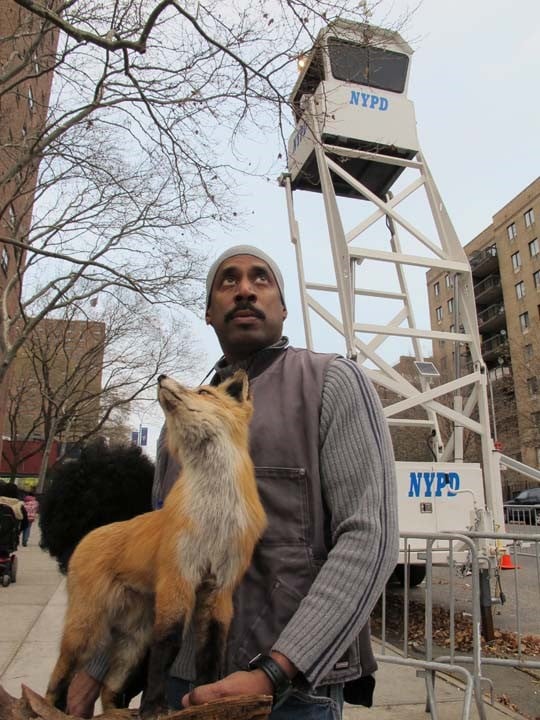
We spoke to artist Nari Ward about his latest body of work, gentrification in Harlem, and the importance of giving back to your community.

Nari Ward has been having a hell of a year. The Jamaican-born artist just celebrated his first New York institutional solo show “G.O.A.T., again,” a new series of outdoor sculptures at the Socrates Sculpture Park in Queens; installed a recent commission of his project We The People (2011) at the New York Historical Society on the Upper West Side; and sees his travelling survey, “Nari Ward: Sun Splashed,” move to the ICA in Boston, on view through September 4, 2017.
All that alone would be enough to keep the man busy, but lo and behold, the restless Ward has an upcoming solo exhibition at Lehmann Maupin opening next month, his fourth with the gallery. “TILL, LIT” will present new works by the artist, from sculpture to installation to mixed media on canvas.
Ward, who is probably best known for his work in assemblage and sculpture, takes a moment to consider and grapple with the possibilities of the flat picture plane. Drawing inspiration from the ruminative abstractions of Mark Rothko, while still maintaining a practice of working with unconventional materials and found objects, these so-called “till” paintings are product of this newfound exploration in material, working with dollar bills, empty cash tills, acrylic paint, and overproof rum. (A second part of the show—the “lit” in the “TILL,LIT” title—is a series of sculptures inspired by police towers in his neighborhood of Harlem, but was still under wraps at the time of our conversation.)
Thinking of art as bridge between capitalism and spirituality, Ward’s “till” paintings complicate the value structure of art. Cutting out the edges of dollar bills and placing them in overlaid pattern against his canvas, while affixing an empty till at its center, the artist is commenting on the work’s use-value in society. Furthermore, as a component of the work Ward and Lehmann Maupin will donate a percentage of the sales to the organization Housing Works, a nonprofit dedicated to helping the homeless and those affected by AIDS in New York City.
Recently, artnet News went to visit Ward at his studio in Harlem to discuss this new body of work, his place in his community, and the material and spiritual transformations of his found objects.
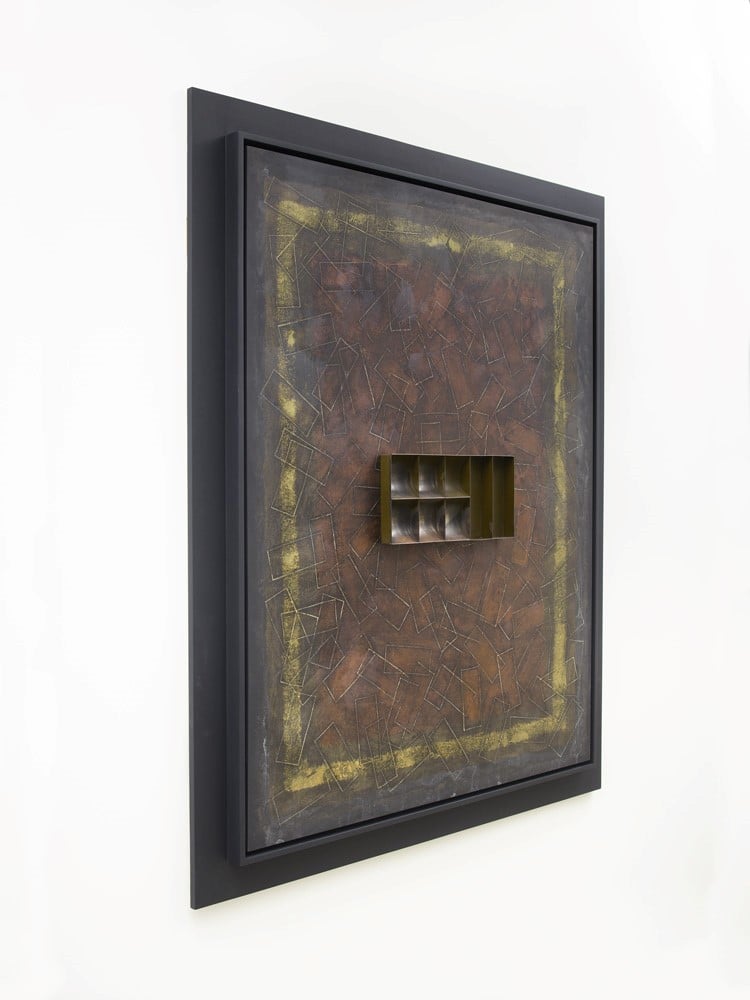
Nari Ward, Royal, 2017. (Detail). Courtesy Lehmann Maupin, New York and Hong Kong.
Tell me about your new work, these “till” paintings. How did this idea come about. In some way this seems like a departure from your earlier work, no?
There are a lot of differences and similarities. But one project that is directly connected to this newer body work is Sugar Hill Smiles (2014), a project organized by No Longer Empty. In that piece, I wanted to capture the smiles of folks in the neighborhood of Sugar Hill in North Harlem. I took these small cans and placed a mirror at the bottom of each one. I had my stand on the street corner and I would get people to look inside and smile, and then I would seal the cans. Later, the canned smiles were sold to raise money for Broadway Housing Communities (BHC), an organization that deals with low income housing in New York.
The proceeds also went to support the Sugar Hill Project, an affordable housing unit in the area. It was also intended to benefit the art programming for the Sugar Hill Children’s Museum of Art and Storytelling, housed inside the building. So this kind of cycle really engaged me, and brought it into the real world. It was activism, but more socially transformative.
I see. So Sugar Hill Smiles acts as a precursor to the “till” paintings, as way of giving back to the community, especially in light of the announcement that you and Lehmann Maupin will be donating a percentage of the sales to Housing Works, an organization whose mission is to end AIDS and homelessness.
That was something that had to happen from the very beginning. I don’t know if the gallery told you—I was pushing for 100 percent. But we negotiated an agreement which allowed us to use the same system to maximize our efforts to create change. And the idea was to think about how that could happen in the “till” pieces—to give back to the community.
The fact that I was working with US currency made it even closer to that notion. Money became the material for the work, and my challenge was how to use it in a way that didn’t disrupt the value of the bill. So the concept was to use the laser cutter to cut off just enough of the edge where the bill still functions. It’s so surgical.
How thin are these dollar edges?
You can see it here. (pointing to the laser cutter) They’re like one sixteenth of an inch. The bill itself feels a little weird afterwards. Something is not right. (laughter) It’s always the one dollar bill too, rather than a 20. If I make a mistake, I don’t have to freak out. I’m interested in the formal qualities, the intimacy of the bill. When this is done, I’m hoping that there will be a desire to really look, to get people to focus on stuff that they don’t normally pay attention to. It’s also about using things that are leftover.
But these works are different from what you’ve done in the past. They’re essentially paintings, which is something quite new for you.
I try to say I’m not a painter, I’m a panelist. But it’s interesting because the lineage of painting is so prescribed. It’s not like working with found objects where they have their own demands, rules, and histories. They guide you on a journey.
That’s why I was really excited about working with money—excising the edges from the dollar bill. I’ve gathered this amazing material and I wanted to say something about it. And when it dawned on me, to bring in the cash tills, the work really became formal, sculptural.
So you were first working with the edges of the dollar bill before you introduced the till as a centerpiece to the work?
I was thinking about money and spirituality, and how they intersect at moments; how they’re somehow about empowerment: “In God We Trust” you know. There’s this connection to divinity. I remember going to see a Rothko show at Pace recently. It was an amazing exhibition. But this is not a nonprofit space—it’s Pace! It’s a blue-chip gallery. And I’m thinking about these paintings, emanating this spirituality, and these guards are there, watching.
I had to make a conscious effort to dissect the economic artifice from this religious experience, and I was thinking, “Wow, that’s interesting.” So it started out with just trying to create these radiating edges—copper, gold, silver edges in the tills, too. And what ended up happening was just emptiness, a void.
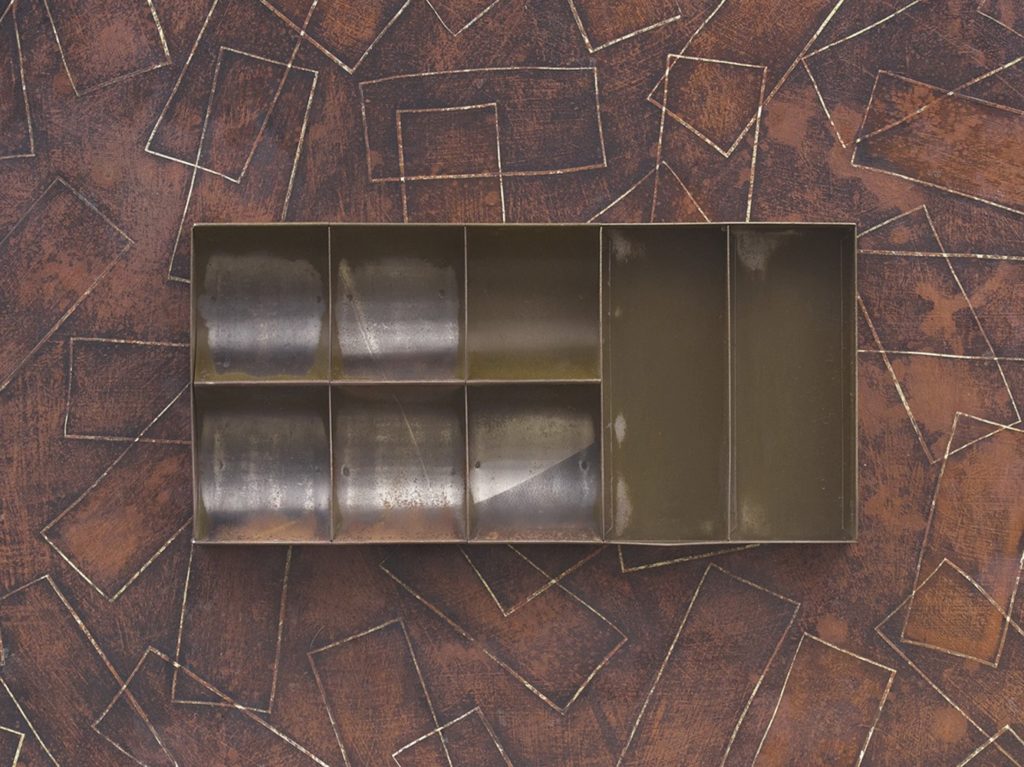
Nari Ward, Royal, 2017, (Detail). Courtesy Lehmann Maupin, New York and Hong Kong.
Like drawing a connection between the emptiness of the Sugar Hill cans as useless objects that still have meaning and social importance. I was going to ask—you have a practice of collecting things, a penchant for using often discarded materials (i.e. fire hoses, baby strollers, bottle, shoe laces, bats). How does the till fit into this vocabulary? Or how did you come to the objects?
It’s weird. Now, it’s all through the internet. I was like a mad man on eBay. (laughter) I’m kind of digging it, negotiating prices. I was like, “This is really fun!” But at the same time, I’m a little pissed off at eBay, because people used to put that stuff out in the garbage! They’ve made life a little harder for artists working with found objects.
I started ordering a bunch of tills and they started driving the aesthetic decisions, based on the way they looked: if they had rust, silver patina, or whatever.
So the actual tills dictated the color scheme of the canvas?
The color scheme, yes, or even how much energy I would try to create with the marks around them. If there was one that was really dark, I would have to balance how much was going on around it. I got really interested in all of that. So at a certain point it was really all driven by the tills, their texture and color.
I heard you’re using white rum in these paintings too. What’s that about?
Man it’s serious! (laughter) I grew up with this stuff.
Oh Wray and Nephew rum! That stuff is dangerous.
It’s delicious. My uncle Felix used this stuff as a cure-all for everything! (laughter) “C’mon over here!,” he’d say and pat you on the head with a little bit of rum. He had a mixture of spices and ganja inside, soaking in the rum. He would then rub it on any ailment that you had. So the rum signifies this idea of spirituality in the “till” project. I would put some silver or gold paint in with the alcohol and just kind of sprinkle it on. I was anointing each piece.
It became a ritual act.
Right. For me it was about bringing that personal, ritualized discourse into the painting structure.
Personal, but also formal.
Exactly. It was also great, because I would come in here and just smell rum! It got to the point where I just wanted to come to the studio just for the smell, that unique sweet smell. And normally, it triggers memories of a jovial space—at a bar, with friends, family. It just makes me happy.
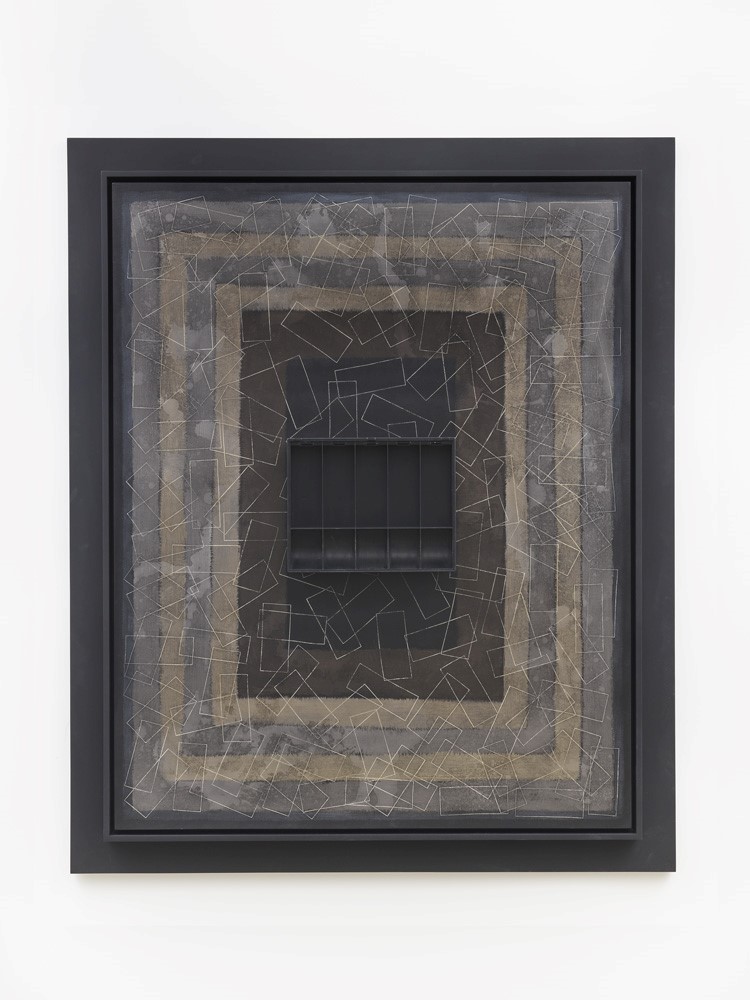
Nari Ward, Royal Alpha, 2017, US currency edges, acrylic paint, indelible ink, overproof white rum, and used cash register drawers. Courtesy Lehmann Maupin, New York and Hong Kong.
I want to get back to this idea of charity or giving back to the community as a point of reference in your work. It makes me think of Mark Bradford and the way he’s using his cachet as a successful artist to accomplish his more charitable projects, selling his work to raise money for the arts organization Art + Practice in his LA community. I’m wondering if your work is in line with his in some way, or if you ascribe to his idea of “social abstraction”—abstract art that has a social and political tinge?
I think Mark separates the two things: There is the work that he does, and then there are the moral decisions he makes from having limitless resources to help people in his community. And I think that even though you can lump those two spheres together, he is in fact using his cachet to generate capital for his social practice. I think artists of color have to be a lot more responsible than the normal celebrity artist in the contemporary art world.
Making art is a privilege in a lot of ways. And so if you have the resources, you want to figure out a way to help as many people as you can. Sometimes other people do it through helping younger artists. For me, it’s always about the white cube—because that’s a history that I am well versed in—and about the community. How to negotiate both of those realities, to build a bridge, so to speak, is what I’m after.
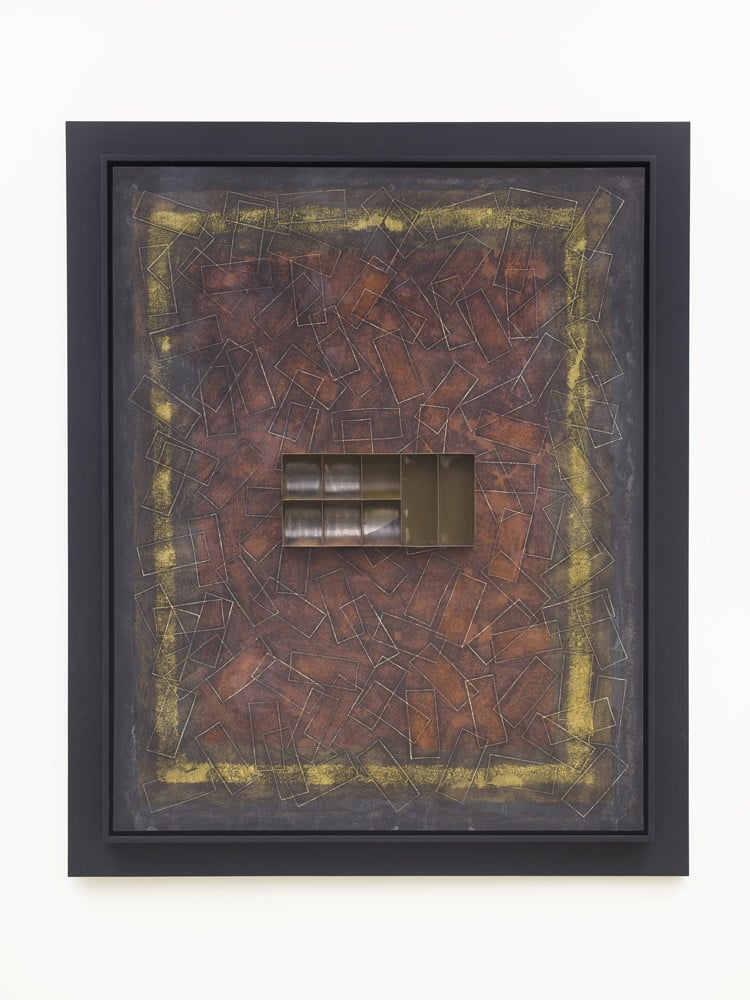
Nari Ward, Royal, 2017, US currency edge s, acrylic paint, indelible ink, overproof white rum, and used cash register drawers. Courtesy Lehmann Maupin, New York and Hong Kong.
That’s interesting. I’m wondering if that has something to do with why the press release for your upcoming show states: “While politically minded, Ward is not an activist, but an alchemist, removing a small part of the transactional economy to add tangible value to the social transformation that takes place in art making.” Can you talk about what it means to identify or not identify as an activist?
I have a lot of respect for that term, that label. Recently, I was at a talk with Tania Bruguera in Boston last week, and she calls herself an “artivist.” I thought that was brilliant. I was like, “Damn, girl.” There are moments when I am excited about an object’s transformation, what it means, its historical resonance in a contemporary art dialogue, its significance within the community. I’m intrigued by that.
And there are times when I want the object to do more, in a performative way, that might produce income for change, you know? But I don’t really feel like I can do both. I’m trying to figure out how to do both. But my concern is how to make work that’s mysterious, but also referential to those larger social concerns. So in some sense it is a type of alchemy. But that’s why I don’t really put myself in the activist role. Material transformation is what interests me.
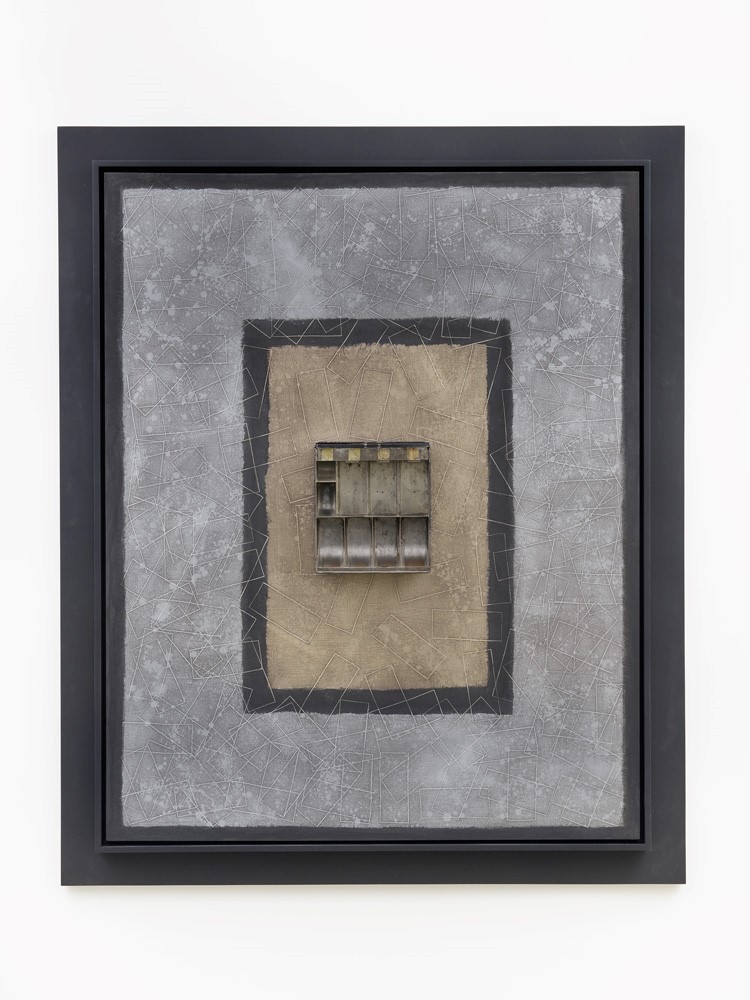
Nari Ward, Sharp, 2017, US currency edge s, acrylic paint, indelible ink, overproof white rum, and used cash register drawers. Courtesy Lehmann Maupin, New York and Hong Kong.
The other thing I wanted to touch on is your relationship to Harlem, and how that permeates your work, and acts as inspiration. I’m also thinking about the rise of homelessness due to gentrification in the Harlem area. Do you feel a sense of anxiety as an artist working in Harlem? What are the consequences of being an artist here? Especially now, with galleries like Gavin Brown Enterprise and Elizabeth Dee setting up shop here. How do you negotiate that?
Seph Rodney wrote a piece about this for Hyperallergic. He thought it was a really bad thing for these contemporary galleries to come in. Because the notion is always the same: Folks are just now discovering the culture. As if suddenly the discourse is just now active.
But that’s why I think it’s really important to push back. The street life is in crisis, because new people are complaining about the noise! But that’s the culture. They’ll be outside at all times of the night, you know. Get used to it. Celebrating that lifestyle is really important, and finding ways to do so is key.
It’s complicated, you know. It’s about expectations. Certain folks come in with their own assumptions that they think will align with others.
The challenge is how to reorient assumptions so that we don’t lose what’s here—without kicking people out, locking them up, really criminalizing people in the community. That’s the biggest challenge of being in Harlem.
A tactic that’s been used a lot now—because it works—is the NYPD light towers. The idea of using light as a symbol of safety, watching, and policing—it’s the same thing, you know, as using castles, fortresses, moats, and horses. It’s a sign of power, control.
And so when that kind of thing happens, what you have to think about is how to complicate it; how to take on the language of those ideas and displace them, so that folks can really think about what is happening and how it is happening. You have to find a way to work in the shadows. In order to negotiate that you have to have a really strong sense of community, otherwise it won’t work.
“TILL, LIT” will be on view at Lehmann Maupin, New York, June 2–August 25, 2017.